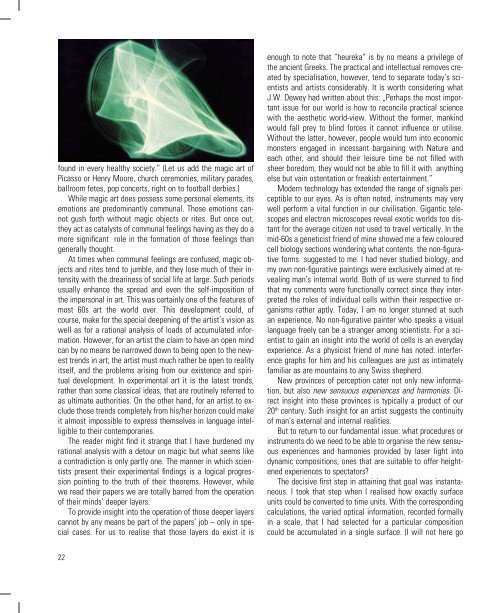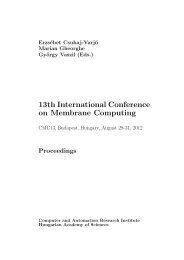Time on the Tilt
Time on the Tilt
Time on the Tilt
You also want an ePaper? Increase the reach of your titles
YUMPU automatically turns print PDFs into web optimized ePapers that Google loves.
found in every healthy society.” (Let us add <strong>the</strong> magic art of<br />
Picasso or Henry Moore, church cerem<strong>on</strong>ies, military parades,<br />
ballroom fetes, pop c<strong>on</strong>certs, right <strong>on</strong> to football derbies.)<br />
While magic art does possess some pers<strong>on</strong>al elements, its<br />
emoti<strong>on</strong>s are predominantly communal. Those emoti<strong>on</strong>s cannot<br />
gush forth without magic objects or rites. But <strong>on</strong>ce out,<br />
<strong>the</strong>y act as catalysts of communal feelings having as <strong>the</strong>y do a<br />
more significant role in <strong>the</strong> formati<strong>on</strong> of those feelings than<br />
generally thought.<br />
At times when communal feelings are c<strong>on</strong>fused, magic objects<br />
and rites tend to jumble, and <strong>the</strong>y lose much of <strong>the</strong>ir intensity<br />
with <strong>the</strong> dreariness of social life at large. Such periods<br />
usually enhance <strong>the</strong> spread and even <strong>the</strong> self-impositi<strong>on</strong> of<br />
<strong>the</strong> impers<strong>on</strong>al in art. This was certainly <strong>on</strong>e of <strong>the</strong> features of<br />
most 60s art <strong>the</strong> world over. This development could, of<br />
course, make for <strong>the</strong> special deepening of <strong>the</strong> artist’s visi<strong>on</strong> as<br />
well as for a rati<strong>on</strong>al analysis of loads of accumulated informati<strong>on</strong>.<br />
However, for an artist <strong>the</strong> claim to have an open mind<br />
can by no means be narrowed down to being open to <strong>the</strong> newest<br />
trends in art; <strong>the</strong> artist must much ra<strong>the</strong>r be open to reality<br />
itself, and <strong>the</strong> problems arising from our existence and spiritual<br />
development. In experimental art it is <strong>the</strong> latest trends,<br />
ra<strong>the</strong>r than some classical ideas, that are routinely referred to<br />
as ultimate authorities. On <strong>the</strong> o<strong>the</strong>r hand, for an artist to exclude<br />
those trends completely from his/her horiz<strong>on</strong> could make<br />
it almost impossible to express <strong>the</strong>mselves in language intelligible<br />
to <strong>the</strong>ir c<strong>on</strong>temporaries.<br />
The reader might find it strange that I have burdened my<br />
rati<strong>on</strong>al analysis with a detour <strong>on</strong> magic but what seems like<br />
a c<strong>on</strong>tradicti<strong>on</strong> is <strong>on</strong>ly partly <strong>on</strong>e. The manner in which scientists<br />
present <strong>the</strong>ir experimental findings is a logical progressi<strong>on</strong><br />
pointing to <strong>the</strong> truth of <strong>the</strong>ir <strong>the</strong>orems. However, while<br />
we read <strong>the</strong>ir papers we are totally barred from <strong>the</strong> operati<strong>on</strong><br />
of <strong>the</strong>ir minds’ deeper layers.<br />
To provide insight into <strong>the</strong> operati<strong>on</strong> of those deeper layers<br />
cannot by any means be part of <strong>the</strong> papers’ job – <strong>on</strong>ly in special<br />
cases. For us to realise that those layers do exist it is<br />
enough to note that “heureka” is by no means a privilege of<br />
<strong>the</strong> ancient Greeks. The practical and intellectual removes created<br />
by specialisati<strong>on</strong>, however, tend to separate today’s scientists<br />
and artists c<strong>on</strong>siderably. It is worth c<strong>on</strong>sidering what<br />
J.W. Dewey had written about this: „Perhaps <strong>the</strong> most important<br />
issue for our world is how to rec<strong>on</strong>cile practical science<br />
with <strong>the</strong> aes<strong>the</strong>tic world-view. Without <strong>the</strong> former, mankind<br />
would fall prey to blind forces it cannot influence or utilise.<br />
Without <strong>the</strong> latter, however, people would turn into ec<strong>on</strong>omic<br />
m<strong>on</strong>sters engaged in incessant bargaining with Nature and<br />
each o<strong>the</strong>r, and should <strong>the</strong>ir leisure time be not filled with<br />
sheer boredom, <strong>the</strong>y would not be able to fill it with anything<br />
else but vain ostentati<strong>on</strong> or freakish entertainment.”<br />
Modern technology has extended <strong>the</strong> range of signals perceptible<br />
to our eyes. As is often noted, instruments may very<br />
well perform a vital functi<strong>on</strong> in our civilisati<strong>on</strong>. Gigantic telescopes<br />
and electr<strong>on</strong> microscopes reveal exotic worlds too distant<br />
for <strong>the</strong> average citizen not used to travel vertically. In <strong>the</strong><br />
mid-60s a geneticist friend of mine showed me a few coloured<br />
cell biology secti<strong>on</strong>s w<strong>on</strong>dering what c<strong>on</strong>tents <strong>the</strong> n<strong>on</strong>-figurative<br />
forms suggested to me. I had never studied biology, and<br />
my own n<strong>on</strong>-figurative paintings were exclusively aimed at revealing<br />
man’s internal world. Both of us were stunned to find<br />
that my comments were functi<strong>on</strong>ally correct since <strong>the</strong>y interpreted<br />
<strong>the</strong> roles of individual cells within <strong>the</strong>ir respective organisms<br />
ra<strong>the</strong>r aptly. Today, I am no l<strong>on</strong>ger stunned at such<br />
an experience. No n<strong>on</strong>-figurative painter who speaks a visual<br />
language freely can be a stranger am<strong>on</strong>g scientists. For a scientist<br />
to gain an insight into <strong>the</strong> world of cells is an everyday<br />
experience. As a physicist friend of mine has noted: interference<br />
graphs for him and his colleagues are just as intimately<br />
familiar as are mountains to any Swiss shepherd.<br />
New provinces of percepti<strong>on</strong> cater not <strong>on</strong>ly new informati<strong>on</strong>,<br />
but also new sensuous experiences and harm<strong>on</strong>ies. Direct<br />
insight into <strong>the</strong>se provinces is typically a product of our<br />
20 th century. Such insight for an artist suggests <strong>the</strong> c<strong>on</strong>tinuity<br />
of man’s external and internal realities.<br />
But to return to our fundamental issue: what procedures or<br />
instruments do we need to be able to organise <strong>the</strong> new sensuous<br />
experiences and harm<strong>on</strong>ies provided by laser light into<br />
dynamic compositi<strong>on</strong>s, <strong>on</strong>es that are suitable to offer heightened<br />
experiences to spectators?<br />
The decisive first step in attaining that goal was instantaneous.<br />
I took that step when I realised how exactly surface<br />
units could be c<strong>on</strong>verted to time units. With <strong>the</strong> corresp<strong>on</strong>ding<br />
calculati<strong>on</strong>s, <strong>the</strong> varied optical informati<strong>on</strong>, recorded formally<br />
in a scale, that I had selected for a particular compositi<strong>on</strong><br />
could be accumulated in a single surface. (I will not here go<br />
“Star-flower”<br />
into <strong>the</strong> details of accumulati<strong>on</strong>.) Following a designated path,<br />
laser light projects <strong>the</strong> compositi<strong>on</strong> <strong>on</strong>to a screen. Laser light<br />
here plays <strong>the</strong> same role as a pick-up needle does <strong>on</strong> a gramoph<strong>on</strong>e<br />
disk. We have named <strong>the</strong> new device a light disk after<br />
<strong>the</strong> gramoph<strong>on</strong>e disk. The rhythm of <strong>the</strong> projecti<strong>on</strong> can be c<strong>on</strong>trolled<br />
by motor-driven transmissi<strong>on</strong>s.<br />
Thus, <strong>on</strong> a single light disk a huge amount of visual informati<strong>on</strong><br />
can be stored. A recorded “laser symph<strong>on</strong>y” can be<br />
reproduced anywhere given <strong>the</strong> device and <strong>the</strong> informati<strong>on</strong>.<br />
Using several co-ordinated lasers and light disks simultaneously,<br />
<strong>the</strong> effect of <strong>the</strong> compositi<strong>on</strong>s shown can be multiplied.<br />
It took some very lengthy teamwork to create <strong>the</strong> exact<br />
technical descripti<strong>on</strong> of <strong>the</strong> new idea, as did to build <strong>the</strong> device,<br />
to compare its effects with earlier visual effects produced<br />
by lasers, and also to upgrade <strong>the</strong> fundamental idea c<strong>on</strong>tinuously.<br />
Our patent descripti<strong>on</strong> records our teamwork, vitally important<br />
for <strong>the</strong> entire project, in detail.<br />
At <strong>on</strong>e stroke, <strong>the</strong> new devices for planned compositi<strong>on</strong><br />
solved my most essential problem.<br />
This was how I could plan <strong>the</strong> spectacle presented at our<br />
22 23
















